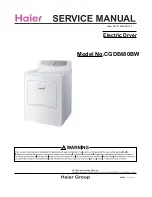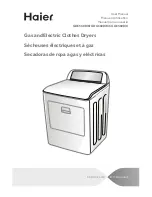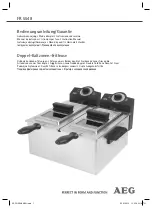
TF2048903-BA-00 English
Page
6
of
16
20180615-V1
If you see, smell, or hear escaping gas, immediately get away from the LP tank /
appliance and call your
FIRE DEPARTMENT.
All spare LP tanks must have safety caps installed on the LP tank outlet.
LP Tank Removal, Transport and Storage
Turn OFF control knobs at regulator and LP tank valve. Turn coupling nut
counterclockwise by hand only
–
DO NOT USE TOOLS TO DISCONNECT
. Place dust
cap on cylinder valve outlet whenever the cylinder is not in use. Only install the type of
dust cap on the cylinder valve outlet that is provided with the cylinder valve. Other
types of caps or plugs may result in leakage of propane.
A disconnected LP tank in storage or being transported must
have a safety cap installed as shown. Do not store an LP tank
in enclosed spaces such as a carport, garage, porch, covered
patio or other building. Never leave an LP tank inside a vehicle
which may become overheated by the sun.
Storage of an appliance indoors is permissible only if the
cylinder is disconnected and removed from the appliance.
Cylinder must be stored outdoors out of the reach of children
and must not be stored in a building, garage or any other
enclosed area.
Turn off gas at supply cylinder when not in use.
LP Tank
The LP tank used with your appliance must meet the following requirements:
Purchase LP tanks only with these required measurements: 12”(30.5cm)(diameter) x
18”(45.7cm)(tall) with 20lb.(9kg) capacity maximum.
The LP-gas supply cylinder to be used must be constructed and marked in accordance
with the specifications for LP-gas cylinders of the US Department of Transportation
(DOT) or the National Standard of Canada, CAN/CSA-B339, Cylinders, Spheres and
Tubes for the Transportation of Dangerous Goods.
LP tank valve must have:
Type 1 outlet compatible with regulator or appliance.
Safety relief valve.
UL listed Overfill Protection Device (OPD). This OPD safety
feature is identified by a unique triangular hand wheel. Use
only tanks equipped with this type of valve.
LP tank must be arranged for vapor withdrawal and include collar to
protect LP tank valve.
LP (Liquefied Petroleum Gas)
LP gas is non toxic, odorless and colorless when produced. For your safety, LP gas
has an odor (similar to rotten eggs) so that it can be smelled.
LP gas is highly flammable and may ignite unexpectedly when mixed with air.
LP Tank Filling
Use only licensed and experienced dealers.
LP dealer must purge tanks before filling.
Dealer should NEVER fill LP tank more than 80% of LP tank volume. Volume of
propane in tanks will vary by temperature.
A frosted regulator indicates gas overfill. Immediately close LP tank valve and call LP
gas dealer for assistance.
Do not release liquid propane (LP) gas into the atmosphere. This is a hazardous
practice.


































